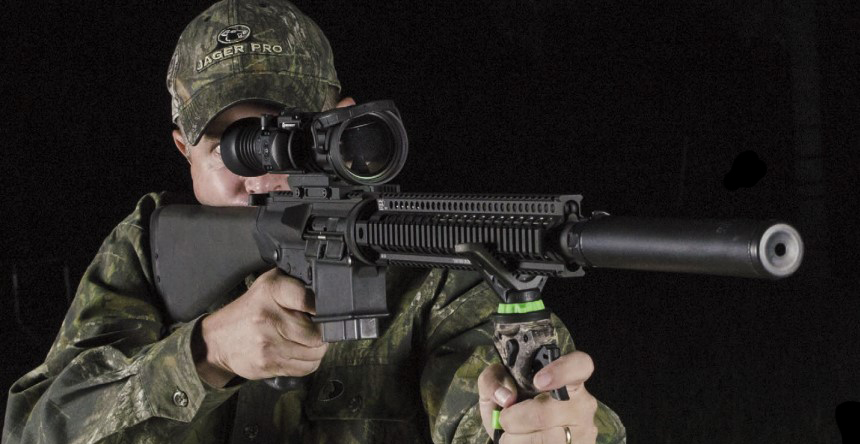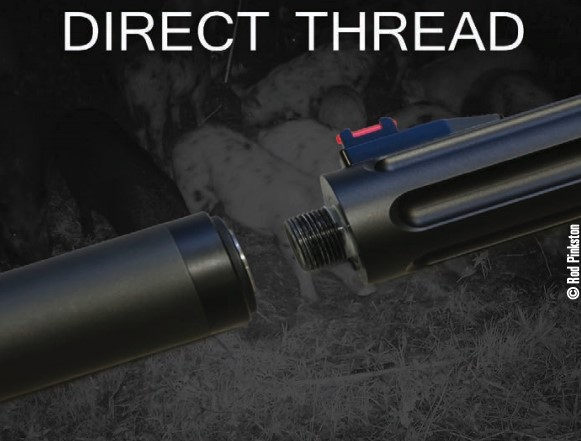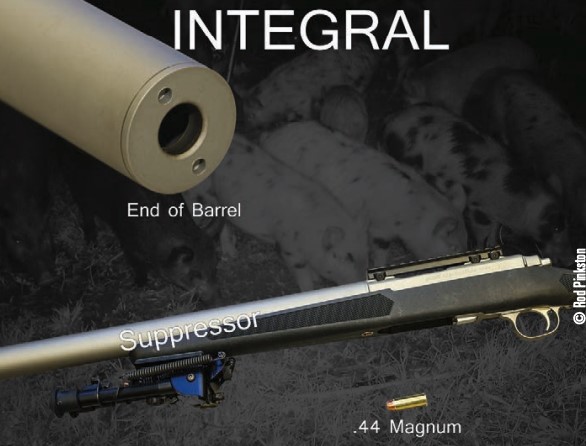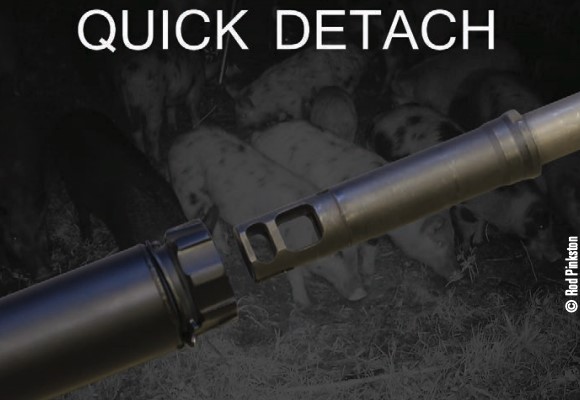Rod Pinkston | Originally published in GameKeepers: Farming for Wildlife Magazine

Alabama became the most recent state to legalize the use of firearm suppressors (or gun silencers) for hunting in October 2014. Despite common perceptions, suppressors are perfectly legal to own unless you live in the 11 states of California, Delaware, Hawaii, Iowa, Illinois, Massachusetts, Minnesota, New Jersey, New York, Rhode Island and Vermont. The other 39 states allow the legal ownership of suppressors and 30 states allow their use for hunting game animals.
The civilian market for firearm suppressors soared 37 percent in 2013 with nearly 500,000 sales compared to 360,000 in 2012 and 285,000 in 2011. Constantly changing legislation and the growing popularity of suppressors gives us an opportunity to educate gamekeepers about firearm suppressors, how they work and how to legally purchase them.
There are multiple sounds associated with the discharge of a firearm. The initial act of pulling the trigger to release the hammer and striking the firing pin is relatively quiet. However, the decibels increase when the firing pin strikes the primer to ignite the gunpowder creating a small controlled explosion inside the cartridge. The resulting pressure propels the bullet forward through the barrel. The loudest noise is produced by the propellant gases exiting the barrel and shredding the surrounding air creating both muzzle blast and muzzle flash.
How Firearm Suppressors Work
According to the Bureau of Alcohol, Tobacco, Firearms and Explosives (BATFE), firearm suppressors (also known as gun or firearm silencers, sound moderators or cans) are defined as: “any device for silencing, muffling or diminishing the report of a portable firearm, including any combination of parts, designed or redesigned and intended for use in assembling or fabricating a firearm silencer and any part intended only for use in such assembly or fabrication.”
In layman’s terms, a firearm suppressor is a gun muffler and works much in the same way a car muffler reduces exhaust noise from an automobile. Both types of mufflers are cylindrical devices much larger in volume (compared to the firearm barrel or exhaust pipe) to provide a controlled environment for hot gases to expand before exiting into the air with less energy and noise. Most firearm suppressors have a cylindrical casing segregated into chambers called baffles. Each baffle has a passage through which the bullet may pass. When the cartridge is fired, the bullet travels the entire barrel and passes through the length of the suppressor. The gases which propel the bullet expand and depressurize into the baffle chambers, where they decelerate considerably (thereby producing less sound) by the time they finally exit the suppressor.
A bullet travelling at supersonic speeds (approximately 1100 feet per second and faster) cannot be suppressed because the bullet creates its own sonic boom commonly referred to as ballistic crack or supersonic crack. Most modern rifle loads are manufactured and designed to travel at supersonic speeds. A firearm suppressor can only dampen the muzzle blast, but not the sound of the bullet's flight. Subsonic ammunition (approximately 1100 feet per second and slower) is available in many common calibers to eliminate the supersonic crack of the bullet. Keep in mind, most rifle caliber bullets are not designed to expand at subsonic speeds and are basically "flying drill bits." They simply punch a hole through the animal with the same sized entry and exit wound with no expansion to create a larger wound channel. Bullets manufactured for pistol calibers (such as .44 magnums) are designed to expand at subsonic speeds and may be a better choice for suppressed rifle operations. These cartridges use heavier bullets to make up for the energy lost by keeping the bullet subsonic but at the cost of lower velocity resulting in decreased range.
A common misconception (and most frequently asked question on our JAGER PRO™ YouTube Channel) is many hunters falsely believe a sounder of feral pigs will continue feeding and allow a hunter to shoot the entire group with a suppressed rifle without any reaction. The reality is most pigs will leave the area at a dead run immediately after the first suppressed shot is fired. The main reason for this negative reaction is an impact noise is still created when the bullet strikes the solid mass of a pig downrange regardless of how well the firearm is suppressed at the muzzle. Also, semi-automatic firearms make plenty of noise as their actions cycle to eject the spent casing and load a new round from the magazine into the chamber.
Firearm Suppressor Mounting Designs
The three most common suppressor mounting designs are direct thread, quick detach and integral.
- Direct thread mounts refer to suppressors which are attached to a barrel via threads. This mount is commonly used by most rimfire and centerfire pistol suppressors. The same direct thread suppressor may be used on multiple firearms.
- Quick detach mounts are a faster attachment method than direct thread mounts. Quick detach suppressors are usually coupled to a semi-permanent barrel adapter such as a muzzle break or a flash hider instead of attaching directly to the firearm’s barrel. My personal preference is a muzzle brake. The suppressor is quick to attach and solid, creating fewer accuracy problems from point of impact shifts. The same quick detach suppressor may also be used on multiple firearms.
- Integral suppressors are manufactured as an essential part of the firearm’s fixed barrel. An integral suppressor cannot be removed or used on another firearm.

Above: Just like the name implies, this type of firearm suppressor is screwed directly onto the barrel.
Below: Integral suppressors are manufactured as a fixed part of the firearm’s barrel and cannot be removed or used on another firearm.

Benefits of Using a Firearm Suppressor for Hunting
There are numerous benefits associated with using firearm suppressors for hunting purposes including reduced noise pollution, reduced recoil, reduced muzzle blast, reduced hearing damage and increased accuracy.
According to Occupational Safety and Health Administration (OSHA), the threshold for a hearing safe impulse noise is 140 dB. Most well engineered .30 caliber suppressors will reduce the report by 25-30 dB taking the noise level below 140 dB. Although suppressors make shooting more comfortable, we still recommend wearing hearing protection because hearing damage is cumulative over a long period of time.
There are competing viewpoints as to whether a suppressed rifle is more accurate. Some believe suppressors generally improve accuracy by promoting the harmonic stabilization of the barrel and by reducing gas induced instability when the bullet exits the muzzle allowing for more accurate shots and faster follow-up shots. Suppressed rifles dramatically increase accuracy among new and inexperienced shooters simply because suppressors significantly reduce recoil and muzzle blast. Novice shooters may not form bad habits caused by flinching and shot anticipation when the firearm produces less recoil and less noise. A more enjoyable experience encourages the additional range time and target practice needed to train breath control, sight alignment and trigger squeeze.

Quick detach suppressors are usually coupled to a semi-permanent barrel adapter such as a muzzle break or a flash hider instead of attaching directly to the firearm’s barrel.
Legality and Ownership of Firearm Suppressors
Firearm suppressors are regulated under the National Firearms Act (NFA) of 1934, which is a branch of the Bureau of Alcohol, Tobacco, Firearms and Explosives (BATFE). NFA items can be registered to an individual, a living trust or a corporation. To legally purchase or possess a firearm suppressor you must:
- Be at least 21 years of age to purchase a suppressor from a dealer.
- Be at least 18 years of age to purchase a suppressor from an individual on an ATF Form 4 to ATF Form 4 transfer (contingent on state laws).
- Be at least 18 years of age to possess a firearm suppressor as a beneficiary of a trust or as a member of a corporation (contingent on state laws).
- Be a resident of the United States.
- Be legally eligible to purchase a firearm.
- Pass a BATFE background check.
- Pay a $200 Transfer Tax.
- Reside in one of the 39 states that currently allow civilian ownership of suppressors - Alabama, Arkansas, Alaska, Arizona, Colorado, Connecticut, Florida, Georgia, Idaho, Indiana, Kansas, Kentucky, Louisiana, Maryland, Maine, ichiganI, Mississippi, Missouri, Montana, North Dakota, Nebraska, Nevada, New Hampshire, New Mexico, North Carolina, Ohio, Oklahoma, Oregon, Pennsylvania, South Carolina, South Dakota, Tennessee, Texas, Utah, Virginia, Washington, Wisconsin, West Virginia and Wyoming. For more in-depth state-by-state gun laws please visit the NRA – ILA website.
Although impact noise is still created downrange when the bullet strikes a solid mass, a firearm suppressor dramatically decreases noise associated with muzzle blast.
Purchasing a Firearm Suppressor
The first step to purchase a firearm suppressor is to locate a Class III dealer in your state of residence who either has or will order your suppressor. The Class III dealer will provide the prospective purchaser (transferee) with the ATF Form 4 which must be completed, in duplicate. Fingerprints also must be submitted on FBI Form FD-258, in duplicate. The ATF Form 4 must be completed on both sides with 2” x 2” passport photos of the prospective buyer taken within the past year affixed to the backside of the form. The “Law Enforcement Certification” section on the rear of the ATF Form 4 must be completed by a chief law enforcement officer to verify the prospective purchaser does not possess a criminal record and is not wanted. The two fingerprint cards (FBI Form FD-258) must be completed and signed by a law enforcement agency.
The completed paperwork is mailed to the Department of the Treasury with a check or money order for $200 known as a transfer tax because it must be paid before ownership of the suppressor is transferred from the dealer to the prospective buyer (transferee). An additional $200 transfer tax (with ATF Form 4) must be paid to the Department of the Treasury each time the suppressor changes ownership to another person. It may make more sense to register the suppressor to a living trust or a corporation.
The approval process has been taking nine to 12 months to receive the stamped ATF Form 4 from the NFA branch. Only then may the dealer allow the transferee to take possession of their new suppressor. A copy of the stamped ATF Form 4 must accompany the suppressor at all times. The original ATF Form 4 should be stored in a safe deposit box. Firearm suppressors can be transported to other states which allow ownership, but transporting a suppressor into one of the states which prohibit private ownership may subject the owner to state felony charges.
As legal use of firearm suppressors for hunting continues to grow, we must educate ourselves about the latest equipment and legislative issues in our state to be informed GameKeepers. Innovative landowners and wildlife managers with modern products and methods play a critical role in effectively managing future wildlife, feral swine and coyote populations on their property.



























